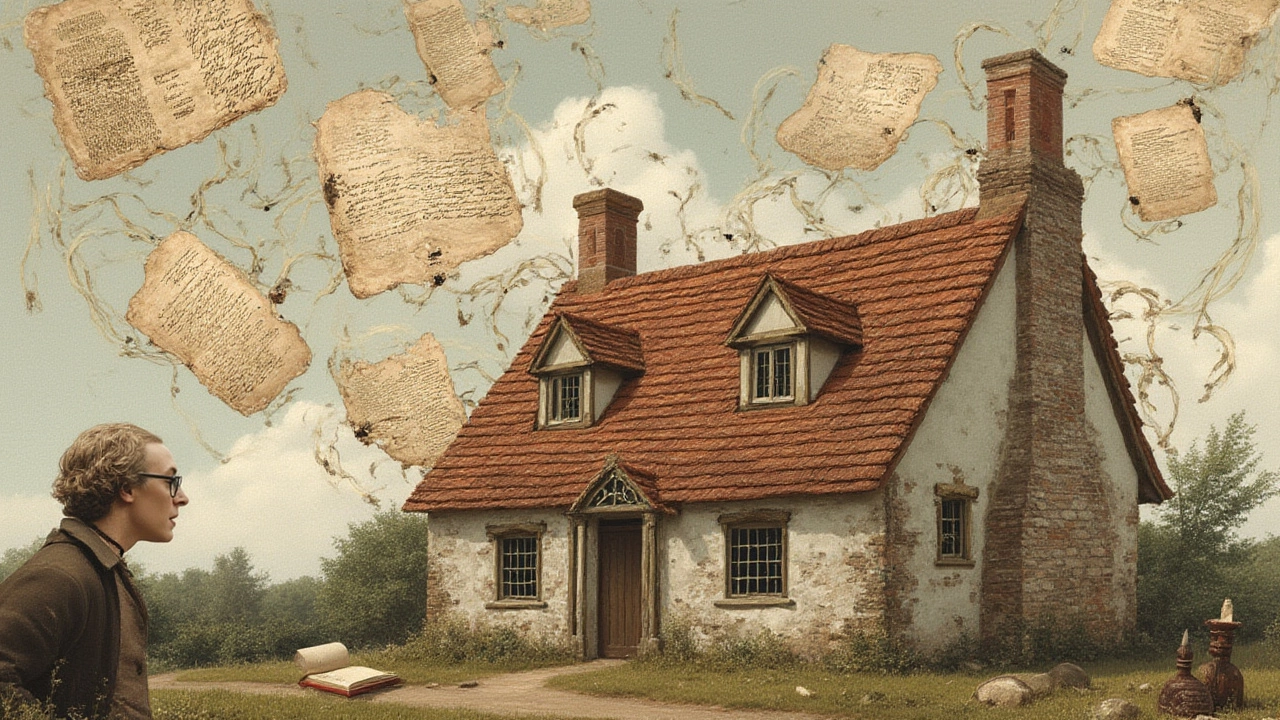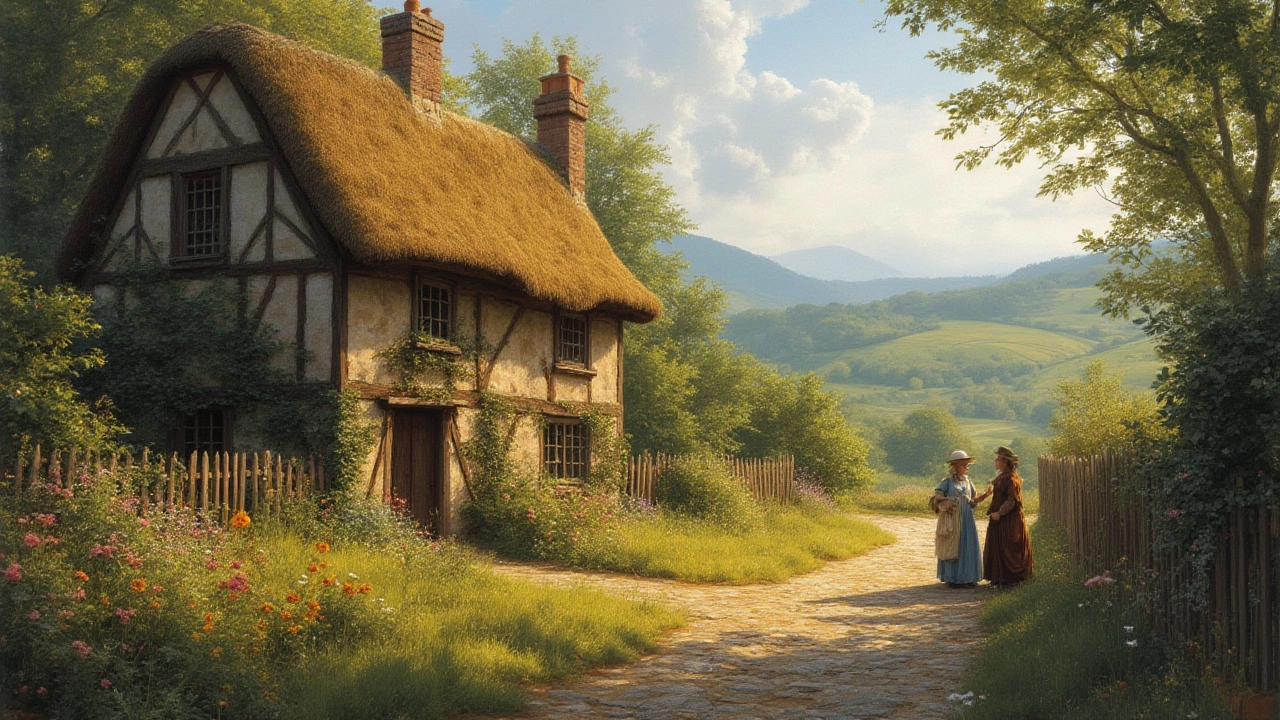There’s something enchanting about the word “cottage.” It sparks cozy images: a thatched roof under leafy branches, a stone pathway, the gentle clatter of teacups inside. But why do we call them cottages, and not anything else—like 'petite houses' or 'country lodges'? The term seems simple, even old-fashioned, but it’s packed with centuries of history, rural rebellion, quirky word twists, and a culture-shaping legacy that reaches across continents.
The Origin of the Word ‘Cottage’
The story behind 'cottage' is a lot older than Pinterest boards filled with checked curtains and mismatched mugs. Linguistically, it’s rooted in the Middle Ages, coming over from Old French: 'cot' or 'cote' meant hut, while 'cotagium' in Medieval Latin described the status of the dwelling or the laborer living within. In 13th-century England, a 'cotter' was someone who worked the land but didn’t own it. They got a tiny bit of ground and a simple structure—a “cottage”—as part of a deal with the lord. Work the soil, you get a roof and some beans. Cottage was both a description and a job title.
By the 15th century, the word had stuck. It traveled and spread—first by law and custom, later in literature. A 'cottage' was legally defined in much of England as a small house with a garden—sometimes just big enough to feed the residents. Jane Austen wrote of them; so did Dickens. Of course, most real cottages weren’t romantic at all. They were rustic, muddy, cold, and often just four walls with a smoky fire inside. But you can thank those medieval laborers (and perhaps their sheep) for the word we still use to describe these homes today.
Many cottage dwellers in the 1700s and 1800s carried the term across the sea to North America and elsewhere. Cottage took on new faces: log or clapboard in New England, whitewashed stone in Ireland, timber-framed in Scandinavia. The style morphed, but the word stuck to any place that felt simple, country, and a bit self-reliant.
If you’re ever tempted to call a two-bedroom city flat a 'cottage,' get ready for a raised eyebrow from a historian: the original meaning was very much rural, tied to the land, and distinct from an urban townhouse. Even as city designers borrowed the idea for small houses meant to feel homey, the country core remains. Language may wander, but old words don’t let go easily.
From Humble Home to Symbol of Escape
For centuries, a cottage was rarely aspirational—until it was. By the time the Industrial Revolution pushed millions into cities, people started looking backward with longing. ‘Cottage’ became a symbol of escape from dirty cities. Suddenly, poets and painters saw beauty in those whitewashed walls. Think of Beatrix Potter’s sweet Lakeland cottage or Monet painting in Giverny. The transformation was helped along by the Romantic movement (famous for praising clouds, sheep, and ruined castles), which recast the messy old rural dwellings as cozy, rustic idylls.
Travel writers in the 1800s began recommending country cottages as the perfect holiday. The word 'cottage' started appearing in advertisements for serene holiday lets, far from the clatter of train stations and soot. Within just a few decades, the term shifted from peasant necessity to middle-class aspiration.
This trend didn’t slow down. From the early 20th century on, 'cottage' became shorthand for escape and authenticity. In places like Canada or New Zealand, suddenly 'going to the cottage' was the summer dream. Families packed fishing rods and flannel pajamas into rickety cars, heading “up north” or “to the lake”—almost always to a cottage, even if it was barely more than a painted shack.
It turned out city people craved what the word suggested: something snug, away from urban grind, with a fire on chilly nights and birdsong in the morning. Even now, rental ads have figured out that 'cottage' is magic for bookings. Call a property a cottage, and watch it disappear off Airbnb in minutes during July. It’s not about four walls; it’s about a feeling—cozy, simple, tucked into a bit of wildness.
Of course, there’s a bit of fantasy in every modern cottage, too. Ironically, many of today’s 'cottages' are larger and fancier than the laborers’ homes ever were, but the name has stuck. When it comes to marketing nostalgia, 'cottage' has no rivals.

Types of Cottages Around the World
You know what’s fun? Cottages come in an astonishing variety. England claims the rose-covered storybook kind—thatch roofs, chimney smoke, stone or wattle and daub. In Scotland, the cottage becomes a croft, with rugged, whitewashed walls built to brave the wind. Head to Sweden, and summer cottages (stuga) are bright red with white trim—tiny but cozy, always near water if possible. Irish cottages often gleam with fresh-washed walls, squat and stout against Atlantic storms, sometimes showing generations’ worth of patchwork repair on one roof.
The North American version bends the rules a bit. A lakeside cottage in Quebec has wood siding, a wraparound porch, and maybe a canoe pulled ashore. Go down to Cape Cod and the 'cottage' means shingles, sandy footprints on the floor, and low ceilings designed for shelter, not show-off. In upstate New York, the 'Adirondack Cottage' is a log cabin in disguise: rough-hewn beams, big porches, lots of plaid.
Australians have their own twist: 'weekender cottages,' often brightly painted and perched above sea breezes. In India, 'cottage' sometimes means a luxury resort suite set apart from the main hotel and dressed up with rustic charm. The French 'maison de campagne' is a whole other vibe—think blue shutters, lavender, and old stone bread ovens.
Here’s a quick snapshot of how cottage types and features compare across a few regions:
| Region | Exterior | Roof Type | Usual Size | Main Feature |
|---|---|---|---|---|
| England | Stone/wattle, roses | Thatch/Slate | 700-1200 sq ft | Chimney, rose gardens |
| Scotland | Whitewashed stone | Slate | 800-1000 sq ft | Fireplace, small windows |
| Sweden | Painted timber | Pitched wood | 400-800 sq ft | Lakeside, wood saunas |
| Canada | Wooden clapboard | Asphalt shingles | 600-1400 sq ft | Deck, lake access |
No matter what country you find yourself in, the point of a cottage remains the same: small, practical, and, above all, a retreat from bigger, busier places. People have always bent cottage design to their local needs and climates, which is why you might see turf roofs in Iceland, bamboo in Southeast Asia, or palm thatch in Belize.
For anyone dreaming of cottage ownership or simply browsing rentals, here are a few quick tips on classic cottage must-haves that still work wonders today:
- Cottage gardens filled with pollinator plants and herbs—not just for looks, but for food and fragrance
- A wood-burning stove or fireplace for authentic cozy nights
- Tiny nooks or window seats for reading (these boost the sense of snug safety)
- Simple, natural materials—like exposed wood beams, stone, or vintage fixtures
- Outdoor spaces: porches, patios, or picnic tables invite lazy afternoons outside
Want to get extra cozy? Swap LED bulbs for a few candle lanterns, stock up on chunky blankets, and pile mismatched crockery on sturdy wooden shelves. Cottage life is about warmth, not perfection.
Cottage Today: Nostalgia and Modern Living
The word 'cottage' is doing heavy lifting in 2025. You’ll see it everywhere—travel booking sites, home decor stores, even beauty brands. It’s not just about the look or the building type anymore. Cottagecore, for example, is an internet-fueled aesthetic that romanticizes farm chores, wildflower meadows, and slower living. People craving meaning (and a break from glowing screens) flock to this trend, baking sourdough bread and arranging dried wildflowers on scrubbed wooden tables.
But not everything about cottage living is just make-believe or hobby-driven. In the last decade, interest in tiny homes and eco-friendly cottages has surged. People want lower energy bills and less clutter. Restoring (or building) a small, efficient cottage is way more appealing than a huge, soulless mansion. Eco-friendly cottages often use natural insulation, solar panels, and old-fashioned tricks like thick walls for heat retention. There’s a wisdom to centuries-old cottage design that fits our sustainable future.
The pandemic years turbocharged the cottage boom in several countries. “Zoom towns” popped up as remote workers realized they didn’t need a city address anymore. A 2023 study in the UK showed rural cottage demand outpacing urban flats for the first time in decades, with prices in western counties rising 17% in just two years. Meanwhile, Canadian realtors keep reporting bidding wars for lakeside cottages—places once dismissed as tired holiday shacks now command hefty price tags.
But the love for the word remains partly rooted in its narrative power: a cottage isn’t just a small house, it’s a promise. Peace and privacy. Ownership of your own little patch, even if it’s just big enough for a tomato plant and a chair. And it doesn’t have to be in the countryside. Urban cottages are thriving on tiny city lots thanks to new zoning, backyard builds, and creative architecture. They keep the ideals—efficient size, self-sufficiency, connection to a garden—even when the setting changes.
So, next time you plop onto a flowered couch or scroll through posts gushing about “cottage weekends,” remember you’re sitting right in the middle of a story that started with muddy boots, tied to a word that’s survived centuries of change. Cottages are freedom as much as they are shelter. Some words just hold on tight for a reason.
